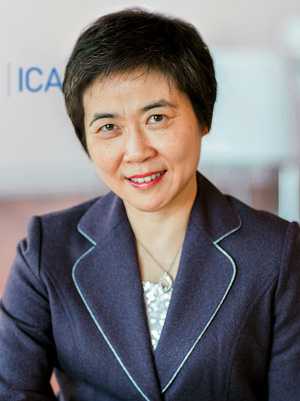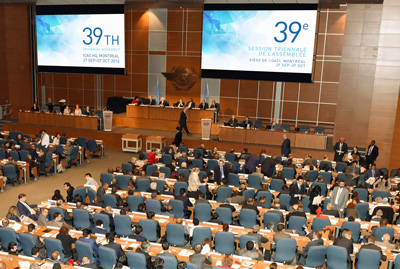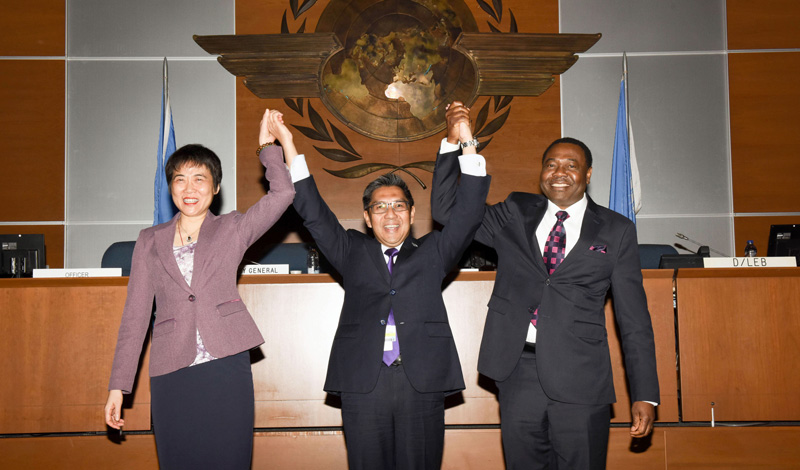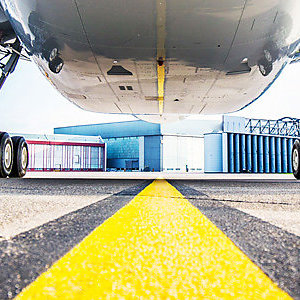Air travel around the world has seen a marked change in the way the aviation industry functions. From its inception, when flying was considered a risky proposition, air travel has now emerged as the preferred means of transportation for long distances between major cities.
The number of passengers passing through the worldʼs airports has grown while the real cost of flying has fallen by 60 % over the last 40 years, making it more accessible to more people. During the same period, aircraft have become more energy-efficient and quieter.
In the midst of all this, technology and strict compliance with standards have helped the International Civil Aviation Organization (ICAO) to weather the storms and ensure continuous improvement in air transport safety and security. Can this be sustained given the growth in air traffic and environmental pressures?
ISOfocus caught up with ICAOʼs Secretary-General, Fang Liu, to discuss how air travel has transformed over the years. Here, Fang Liu looks at how the industry has met the challenges of the recent past and unveils ICAOʼs new measures to meet the challenges of the future. Above all, she explains why collaboration and partnership with ISO is of such vital importance in building a resilient global security framework.
ISOfocus: The air transport sector today carries more than 3.5 billion passengers and 51 million tonnes of freight annually, and it is expected to grow significantly in the years ahead. To what extent is ICAO addressing these future needs and what role are ISO standards playing in ICAOʼs efforts?

Fang Liu: The air transport industry, both in terms of passengers and freight, has roughly doubled in volume every 15 years over the last half century. This has been despite various economic slowdowns, pandemic crises, wars, or security crises such as 9/11, and we have no reason to expect anything different over the next 15 years.
If you add to that the fact that we are safer and more efficient as a global network than we have ever been, by any measure – and certainly when rated against other forms of transport – it is clear that a continuous improvement process is being undertaken.
Many of these gains have been brought about by improved technology and a universal compliance with strict standards, which cover all aspects of aviation design, manufacturing and operation. There are some strict safety and security regulations and other standards which are generated by ICAO itself, standards that member states bring to our attention from their own processes. At the same time, industry-specific standards organizations, such as SAE International, the Radio Technical Commission for Aeronautics (RTCA) and the European Organization for Civil Aviation Equipment (EUROCAE), develop specialized aviation technical specifications. Other standards-making organizations, such as ISO, develop more important generic standards, which we all comply with. These all come together as parts of the total system that is realizing such good results today.
For the future, we can expect much more of the same continuous improvement. While air traffic is increasing, the available airspace and airport capacity is not. This means we need to find new ways to enhance the performance of the system to accommodate smaller distances between aircraft in a wide range of scenarios, while maintaining or improving our current safety records.
The good news is that we have a plan for that called the Global Air Navigation Plan and, within that plan, there are a wide range of aviation system block upgrades – or ASBUs, as we refer to them. In each of those ASBUs, you can find the necessary upgrade roadmaps with respect to technologies, procedures, training and, of course, the standards that will be required.
ISO already has an Unmanned Aircraft Systems Committee up and running (ISO/TC 20/SC 16), which will provide vital standards for the future implementation of remotely piloted aircraft operating in non-segregated airspace, one of the key ASBUs in the Global Air Navigation Plan.
Aviation is one of the fastest-growing sources of greenhouse gas emissions. What action is being taken by ICAO to reduce aviation emissions and develop measures with a global reach?

The year 2016 has, in fact, been the most historic in aviationʼs history in terms of progress on emissions reduction from our sector. International aviation presently contributes 1.3 % of global anthropogenic carbon dioxide (CO2) emissions, but we also recognize that our sector continues to grow given its much appreciated contributions to global trade and the socio-economic objectives of many states and regions.
Most importantly, ICAO forged historic and pragmatic consensus on a new global market-based measure (GMBM) to mitigate international flight emissions, namely the Carbon Offsetting and Reduction Scheme for International Aviation, or CORSIA.
CORSIA is a world first for any industry sector. And while some had presumed that our states would agree to it only in principle and not in practice, we were greatly encouraged at our 39th Assembly when states representing more than 86 % of international traffic proactively volunteered to participate in the scheme from its earliest pilot phase.
In early 2016, ICAO also developed and recommended a new global CO2 standard for aircraft. This is the first CO2 emissions standard for any industry sector, and with the 39th Assembly welcoming this development, we can now look forward together to a greener generation of aircraft entering service as of 2020.
I would note that these developments serve to complement the progress already being achieved by air transport under the Basket of Measures which our member states agreed to pursue at our 37th Assembly, in 2010, to begin limiting aviation-related emissions. This includes four elements, namely: new and innovative aircraft technologies; streamlined operational improvements to reduce aircraft noise and fuel burn; the wider deployment and use of sustainable alternative fuels; and the recently agreed GMBM which will now complement the progress being made in all other areas.
These measures were seen as the primary means by which the international air transport sector would seek to achieve its aspirational goals, also agreed through ICAO, of a recurring 2 % annual fuel efficiency improvement and carbon-neutral growth from 2020. Each category of measures has already made important contributions, which are helping aviation to surpass its 2 % annual target, while still holding out potential for further emissions reductions in the years ahead.

From left: ICAO Secretary-General Fang Liu, ICAOʼs 39th General Assembly President, Azharuddin Abdul Rahman, and ICAOʼs Council President, Dr Olumuyiwa Benard Aliu.
The first ever Global Aviation Safety Plan was designed to serve as a strategic coordination tool. Where do you see the role of international cooperation and ISO standards with respect to ICAOʼs safety priorities?
Aviation safety is a team sport and international cooperation is absolutely essential to effect any enhancements to the system. The Global Aviation Safety Plan acts as the blueprint to make that happen. It identifies where our areas of weakness might be in the system and steers us in the direction to make effective improvements.
For example, in some areas we still need to focus on compliance with the current safety standards to gain those improvements, whereas in others we need to transition to a performance-based model that requires the implementation of safety management systems and state safety programmes to effect the necessary incremental changes to risk profiles.
Again, international cooperation between all the industry players is essential and ISO is an integral part of the team. For example, the commonly known ISO 9000, Quality management systems – Fundamentals and vocabulary, is a critical element in our requirements for the provision of aeronautical information services at the compliance level and its provisions are also instrumental in giving us the robust data that is needed for the integrity of safety management systems.
A major factor threatening security, not only in the skies but also on the ground, is acts of terrorism against civil aviation. How successful has ICAO been in this regard?

We have been very successful and, in many respects, ISO has been a very close partner in some of ICAOʼs most important contributions to a more resilient global security framework. I would also stress that our 39th Assembly has asked ICAO to fast-track the development of a new Global Aviation Security Plan.
In travel document standardization, the technical specifications sections of ICAO Doc 9303, Machine-Readable Travel Document, have received the endorsement of ISO as ISO/IEC 7501, Identification cards – Machine-readable travel documents.
This endorsement is made possible by means of a liaison mechanism through which manufacturers of travel documents, readers and other technologies provide technical and engineering advice to the ICAO Technical Advisory Group on the Traveller Identification Programme (TAG/TRIP) under the auspices of ISO/IEC. Through this working relationship, the ICAO specifications have achieved, and are expected to continue to receive, the status of worldwide standards by means of a simplified procedure within ISO.
The ICAO liaison mechanism with ISO has been successfully applied not only to the endorsement of new specifications for travel documents as ISO/IEC standards, but also to the approval of amendments to the specifications. Subsequent revisions to Doc 9303 will, therefore, be processed for endorsement in precisely the same manner.
This arrangement between our two organizations has been in place since the 1980s and has been fundamental in underpinning the development and maintenance of the heavily relied on international ICAO specifications for machine-readable travel documents.
With some 12 000 standards and recommended practices covering safety, air navigation, security, environmental protection and many other areas of air transport activity, ICAO continues to actively collaborate with ISO as a liaison member to many of its committees (since 1989). How would you describe this collaboration?
I would describe this collaboration as a partnership. Each organization has a different role to play but both are absolutely critical to the total system. ICAO cannot operate as a stand-alone standards-making organization and would be out of its depth in terms of both capacity and capability where the subject matter entrusted to other standards-making organizations is concerned.
We have an Aviation Standards Roundtable that is intended to make sure that the different organizations are coordinating their work efficiently, and to ensure we arenʼt leaving any gaps unaddressed concerning the standards required to deliver the ASBUs, our travel document provisions and other aviation initiatives.
Partnerships are essential to almost everything we do in ICAO and it is worth reiterating that cooperation has been the hallmark of our progress in international civil aviation since ICAO was established in 1944.

